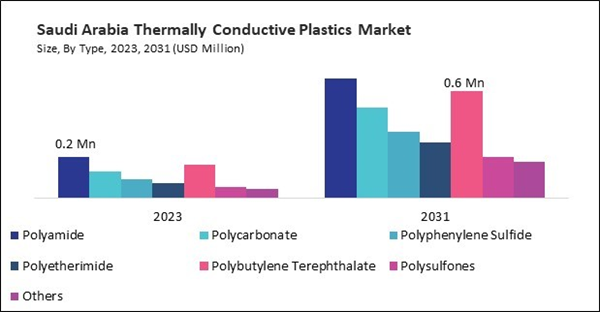Thermally Conductive Plastics play a critical role in various medical devices and equipment, ensuring efficient heat dissipation and thermal management. These plastics are utilized in applications such as diagnostic equipment, patient monitoring devices, surgical instruments, and medical imaging systems. The ability of thermally conductive plastics to effectively dissipate heat generated by electronic components helps maintain the reliability and performance of medical devices, especially those used in critical care settings. Thus, in UAE, 119.0 tonnes of Thermally Conductive Plastics are expected to be utilized in healthcare & pharma by the year 2031.
The Brazil market dominated the LAMEA Thermally Conductive Plastics Market by Country in 2023, and is forecast to continue being a dominant market till 2031; thereby, achieving a market value of $9.57 millions by 2031. The Argentina market is capturing a CAGR of 16.6% during (2024 - 2031). Additionally, The UAE market would register a CAGR of 15.3% during (2024 - 2031).
Thermally conductive plastics often offer cost advantages compared to traditional metal heat sinks and thermal management solutions. Their manufacturing processes can be more cost-effective, particularly for complex geometries and customized designs. Additionally, their lightweight nature can result in savings in transportation costs, energy consumption, and overall system costs, further enhancing their cost-effectiveness for manufacturers.
One key advantage of thermally conductive plastics is their design flexibility. These materials enable creative solutions and improve thermal performance since they can be molded into intricate shapes and seamlessly incorporated into product designs. Manufacturers can tailor thermally conductive plastics’ thermal conductivity, mechanical properties, and aesthetics to meet specific application requirements, enabling greater design freedom and customization.
With industrial production on the rise, there would be a heightened demand for thermally conductive plastics within Brazil’s manufacturing sector. These plastics are crucial in various industries, including automotive, electronics, and machinery manufacturing, where they are used for thermal management in components like LED lighting systems, electronic enclosures, and motor housings. According to the agência IBGE notícias, Brazilian industrial production grew 0.9% from February to March. The gain in pace follows the 0.1% change seen in the previous month. Likewise, with a higher healthcare budget, there could be an increased demand for medical devices and equipment in the UAE. Thermally conductive plastics are used in various medical devices such as diagnostic equipment, monitoring devices, and imaging machines. Hence, growing healthcare expenditure and increasing regional industrial output propel the market’s growth.
List of Key Companies Profiled
- Celanese Corporation
- SABIC (Saudi Arabian Oil Company)
- BASF SE
- Koninklijke DSM N.V.
- DuPont de Nemours, Inc.
- Lanxess AG
- Ensinger GmbH
- Toray Industries, Inc.
- Kaneka Corporation
- Covestro AG
Market Report Segmentation
By Type (Volume, Tonnes, USD Million, 2020-2031)- Polyamide
- Polycarbonate
- Polyphenylene Sulfide
- Polyetherimide
- Polybutylene Terephthalate
- Polysulfones
- Others
- Electrical & Electronics
- Automotive
- Industrial
- Aerospace
- Healthcare & Pharma
- Telecommunications
- Others
- Brazil
- Argentina
- UAE
- Saudi Arabia
- South Africa
- Nigeria
- Rest of LAMEA
Table of Contents
Companies Mentioned
- Celanese Corporation
- SABIC (Saudi Arabian Oil Company)
- BASF SE
- Koninklijke DSM N.V.
- DuPont de Nemours, Inc.
- Lanxess AG
- Ensinger GmbH
- Toray Industries, Inc.
- Kaneka Corporation
- Covestro AG
Methodology

LOADING...









